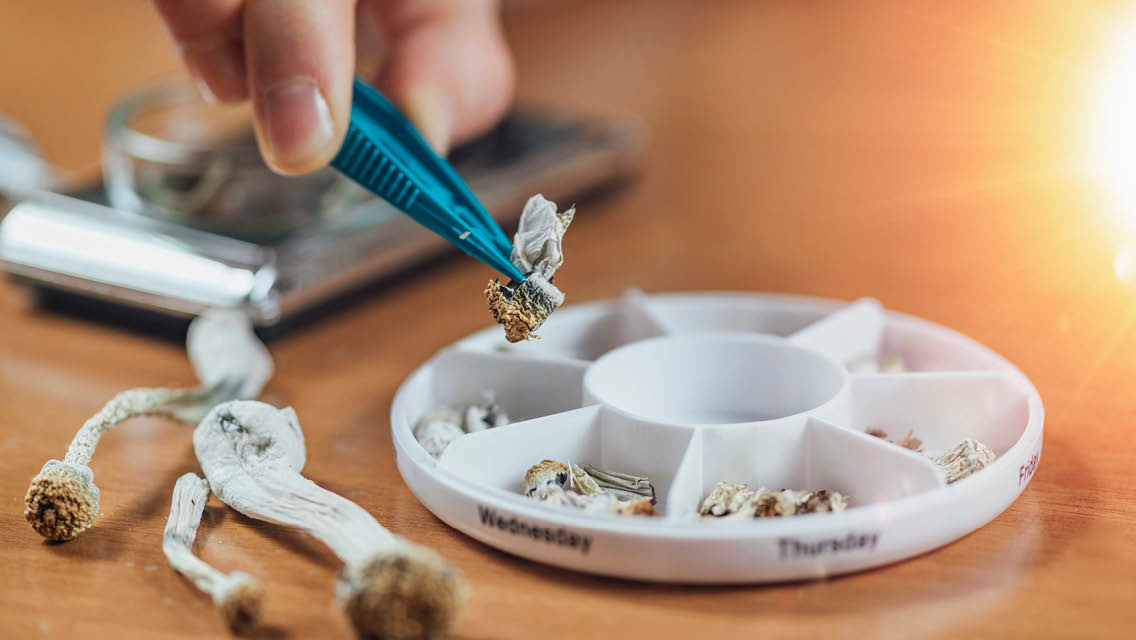A growing body of research suggests that psychedelics — psychoactive substances that temporarily alter mood, cognition, and perception — hold enormous potential for mental-health care. Overcoming their controversial reputation, however, has been no easy feat.
A Long, Messy History
Psychedelics encompass a range of substances, some natural, some synthetic. Indigenous cultures throughout the Americas have used psilocybin mushrooms, ayahuasca, and peyote for millennia. But one of the most famous psychedelic substances, LSD (lysergic acid diethylamide), was first synthesized in a lab less than a century ago.
Midway through the 20th century, Western researchers began exploring the potential for psychedelics to treat addiction and mental illness, publishing more than a thousand clinical papers on psychedelic-drug therapy between 1950 and the mid-1960s alone.
But users of these drugs are at risk of reckless or even deadly behavior. Famously, Harvard researcher Timothy Leary, PhD, advocated for psychedelics while largely abandoning clinical protocols in his research. Leary’s actions, in part, spurred a backlash against psychedelics in the late 1960s and the wholesale ban on production, research, and personal use of the substances.
In the past two decades, the tide has shifted again. A landmark 2006 Johns Hopkins study demonstrated that psilocybin can generate positive changes in attitude and behavior lasting several months, reigniting interest in psychedelics as a psychiatric treatment. Subsequent studies affirmed and expanded on these findings, and in 2018 the FDA granted psilocybin “breakthrough therapy” status.
This speaks to the enormous promise psychedelic compounds hold for treating some of the most intractable mental-health conditions.
How Psychedelics Change the Brain
The brain is complex, and how neurological processes are affected by psychedelics is not entirely clear. But the secret seems to lie in a system called the default mode network (DMN).
The DMN switches on when the brain is not actively engaged in a task — for example, during cognitive processes such as daydreaming, rumination, or “mental time travel” (imagining the future or remembering the past).
Psychological changes can linger for months or even years, fostering longstanding improvements across a range of mental-health disorders.
Though adaptive in many situations, these functions can easily become problematic: Planning ahead turns into worry about what might go wrong; analyzing past mistakes can become a cycle of ruminating, which can veer into self-loathing. And because repeated patterns of thought tend to crystallize, over time these tendencies can lead to addiction, depression, anxiety, and other mental illnesses.
Psychedelics are believed to temporarily quiet the DMN and activate connections between other regions of the brain. Whereas the mind normally follows well-worn roads, psychedelics open alternative routes — some of which may offer profound new perspectives.
And because users remain conscious while under the influence, their travels can be recalled and integrated into real life long after the trip ends. Psychological changes can linger for months or even years, fostering longstanding improvements across a range of mental-health disorders.
- Depression: A study of individuals diagnosed with major depressive disorder found that two sessions of psilocybin coupled with psychotherapy yields rapid, substantial, and sustained easing of symptoms.
- Substance use: Eight in 10 cigarette smokers who received two or three sessions of psilocybin alongside traditional smoking-cessation treatment remained fully abstinent six months later. Another psychedelic, ibogaine, was found to reduce or eliminate opioid use after a single session.
- PTSD: MDMA (methylenedioxymethamphetamine) diminished symptoms of PTSD so dramatically that after two sessions, 83 percent of study participants no longer met criteria for the disorder. A three-year follow-up found the effects had been sustained.
- Coping With Terminal Illness: Several studies have shown that cancer patients treated with LSD and other psychedelics experienced significantly lower anxiety and depression stemming from their diagnosis. Participants also reported less fear of death and “existential distress.”
While psychedelics do not have the same addictive properties as other drugs, they must be handled with care and administered in a controlled setting by a trained professional. Additionally, they’re not for everyone — individuals predisposed to certain mental illnesses, such as schizophrenia, may experience adverse reactions.
And, importantly, they’re not a cure-all. Psychedelics work best in conjunction with, not as a replacement for, psychotherapy.
In other words, a psychedelic experience can open doors, but it still takes time, effort, and support to walk through them.
This article originally appeared as “The Promise of Psychedelics in Mental-Health Care” in the March 2022 issue of Experience Life.





This Post Has 0 Comments